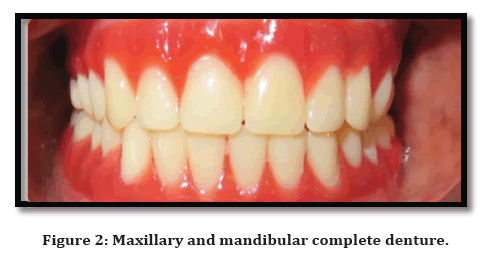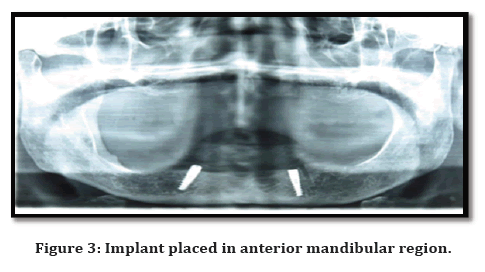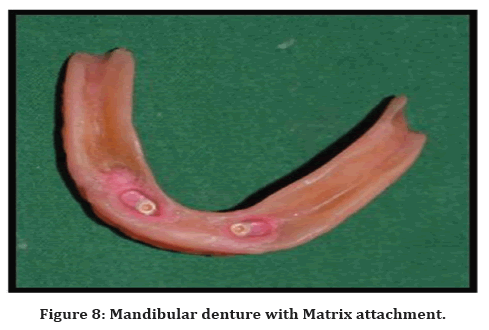Case Report - (2022) Volume 10, Issue 4
Implant Supported Over Denture Using Customized Abutment-A Case Report
Sameera Y*, Arun Prasad NC, Gokul S and Nagappan C
*Correspondence: Sameera Y, Department of Prosthodontics, Karpaga Vinayaga Institute of Dental Sciences, India, Email:
Abstract
A mandibular over denture supported by two implants is a cost effective treatment option for a maladaptive denture wearer. With ball attachment commonly practiced, their parallelism plays a vital role in long term success. The following report describes the procedure to correct a nonparallel implant abutment to retain a mandibular over denture using customized implant abutment.Keywords
Implant over denture, Customized abutment, Mandibular implant, complete denture
Introduction
Over denture is a dental prosthesis that covers and is partially supported by natural teeth, natural tooth roots or dental implants [1]. The connection between the implant and the restorative components plays a critical role in the long-term functional and esthetic success of the implant prosthesis. This article is a case report involving the use of customized abutment on each implant to ensure correct alignment among ball attachments and its retentive component.
Case Report
A55 year old female presented with a chief complaint of an uncomfortable and non-retentive mandibular denture (Figure 1). Patient had no relevant medical history, had underwent extraction since 4 years and a denture wearer since then. After consultation with the patient, various treatment options, including fixed and removable prostheses, were presented. Due to limited financial resources, the decision was made to provide an IOD retained by 2 non-splinted implants in the anterior region, with a ball attachment.

Figure 1. Surgical training questionnaire
Complete denture was fabricated (Figure 2) with conventional technique. CBCT was evaluated for bone and nerve evaluation. Due to narrow ridge two implants(Figure 3) were placed in the anterior mandible 3*13 in 33 region and 3*11 in 32 region (ADIN Dental Implant Systems Ltd., Israel) Following a 3-month healing period, the implants were exposed for prosthetic rehabilitation.

Figure 2. Surgical training questionnaire

Figure 3. Surgical training questionnaire
Impression was made with alginate for fabrication of custom tray (DPI Cold Cure, Denture Base Material, Dental Products of India, Mumbai) (Figure 4) for implant level impression. Impression was made with custom tray using poly vinyl siloxane medium body impression material with open tray impression coping (ADIN Dental Implant Systems Ltd., Israel) hand tightened to implant (Figure 5). After retrieving the impression, Implant analog was then tightened to open tray coping and a definitive cast poured. As both implants were non parallel, a customized abutment was fabricated correcting the parallelism (Figure 6). The retentive component (matrix) was added to the abutment (Figure 7) and the existing over denture was adjusted to create adequate space for the retentive component to be transferred to the prosthesis. The abutment undercuts were blocked out. Venting holes were made in the over denture for expressing excess acrylic resin, and auto polymerizing acrylic resin (DPI Cold Cure, Denture Base Material, Dental Products of India, Mumbai) .Upon removal of the denture, irregularities and voids in the intaglio surface of the denture around the attachments were filled in with additional auto polymerizing acrylic resin (Figure 8). Excess acrylic resin was removed; the denture was polished and inserted (Figure 9).

Figure 4. Surgical training questionnaire

Figure 5. Surgical training questionnaire

Figure 6. Surgical training questionnaire

Figure 7. Surgical training questionnaire

Figure 8. Surgical training questionnaire

Figure 9. Surgical training questionnaire
Discussion
Implant over denture can be an optimum choice for completely edentulous patients, who cannot opt for fixed implant prosthesis due to compromised posterior bone quality, anatomical limitations, increased treatment cost, and systemic medical condition [2-4]. Over dentures may be retained by a number of different implants, which can be splinted or separate [5]. In 2002, McGill consensus published that the treatment modality of choice for the edentulous mandible should be a two-implant retained over denture [6]. Vere, Bhakta, and Patel stated: “Two free-standing implants in the canine regions, as the simplest option, would appear to be the treatment of choice to retain an over denture in the edentulous mandible” [7]. Authors have reported high implant survival rates for mandibular over dentures, and thus, successful treatment outcomes when over dentures are retained by two implants splinted or non-splinted [8].
The following treatment concepts have been summarized by Shadow sky (2001) [9]. The mandibular over denture retained by implants in the area between the foramina maintains bone in the anterior mandible. The average annual bony ridge height physiological shrinkage is about 0.4 mm in the edentulous anterior mandible. Studies have revealed better patient-based results when two-implant supported mandibular over dentures have been used compared with conventional lower dentures.
When two implants are used in the anterior mandible to retain an over denture, solitary ball attachments are more economical, easier to clean than bars that are more retentive, less technique sensitive, and more suitable for tapered arches. There appears to be no statistical difference when comparing long-term maintenance of mandibular implant over dentures retained by two implants in contrast to those retained by three or more implants.
Study by Walton et al. [10] has shown that there are a higher number of repairs required when the lingual inclination of implants was greater than 6 degrees or if the facial inclination was less than 6.5 degrees. The lingual inclination was estimated to be greater than 6 degrees for the patient presented in this report. A bar may have been considered as an option to correct the angulation problem. However, financial limitations and concern for oral hygiene access were contraindications to the use of a bar.
Conclusion
This case report describes a procedure to manage a situation in which 2 none splinted mandibular over denture implant abutments that lack parallelism. This technique minimizes chair time and is an alternative to a more costly and complicated bar prosthesis.
References
- https://www.academyofprosthodontics.org/lib_ap_articles_download/GPT9.pdf
- Mericske‐Stern R, Taylor TD, Belser U. Management of the edentulous patient. Clinical Oral Implants Res 2000; 11:108-25.
- Chowdhary R, Kumararama SS. “Simpli5y” a noval concept for fixed rehabilitation of completely edentulous maxillary and mandibular edentulous arches: A 3‐year randomized clinical trial, supported by a numerical analysis. Clinical Implant Dent Related Res 2018; 20:749-55.
- Gonzalez-Gonzalez I, deLlanos-Lanchares H, Brizuela-Velasco A, et al. Complications of fixed full-arch implant-supported metal-ceramic prostheses. Int J Environmental Res Pub Health 2020; 17:4250.
- Dudic A, Mericske‐Stern R. Retention mechanisms and prosthetic complications of implant‐supported mandibular overdentures: Long‐term results. Clin Implant Dent Related Res 2002; 4:212-219.
- Feine JS, Carlsson GE, Awad MA, et al. The McGill consensus statement on overdentures. Montreal, Quebec, Canada. May 24-25, 2002. Int J Prosthodont 2002; 15:413.
- Vere J, Bhakta S, Patel R. Implant-retained overdentures: a review. Dent Update 2012; 39:370-5.
- Meijer HJ, Raghoebar GM, Batenburg RH, et al. Mandibular overdentures supported by two or four endosseous implants: A 10‐year clinical trial. Clinical Oral Implants Res 2009; 20:722-8.
- Sadowsky SJ. Mandibular implant-retained overdentures: a literature review. J Prosthetic Dent 2001; 86:468-73.
- Walton JN, Huizinga SC, Peck CC. Implant angulation: A measurement technique, implant overdenture maintenance, and the influence of surgical experience. Int J Prosthodontics 2001; 14.
Indexed at, Google Scholar, Cross Ref
Indexed at, Google Scholar, Cross Ref
Indexed at, Google Scholar, Cross Ref
Indexed at, Google Scholar, Cross Ref
Indexed at, Google Scholar, Cross Ref
Indexed at, Google Scholar, Cross Ref
Author Info
Sameera Y*, Arun Prasad NC, Gokul S and Nagappan C
Department of Prosthodontics, Karpaga Vinayaga Institute of Dental Sciences, Chinnakollambakkam, Madhuranthagam, Kanchipuram Dt Tamil Nadu, IndiaCitation: Sameera Y, Arun Prasad NC, Raghunathan J, Vinoth Kumar, Gokul S, Nagappan C, Kamala Kannan, Implant Supported Over Denture Using Customized Abutment-A Case Report, J Res Med Dent Sci, 2022, 10 (4):104-107.
Received: 30-Mar-2022, Manuscript No. JRMDS-22-59042; , Pre QC No. JRMDS-22-59042 (PQ); Editor assigned: 01-Apr-2022, Pre QC No. JRMDS-22-59042 (PQ); Reviewed: 15-Apr-2022, QC No. JRMDS-22-59042; Revised: 20-Apr-2022, Manuscript No. JRMDS-22-59042 (R); Published: 27-Apr-2022
